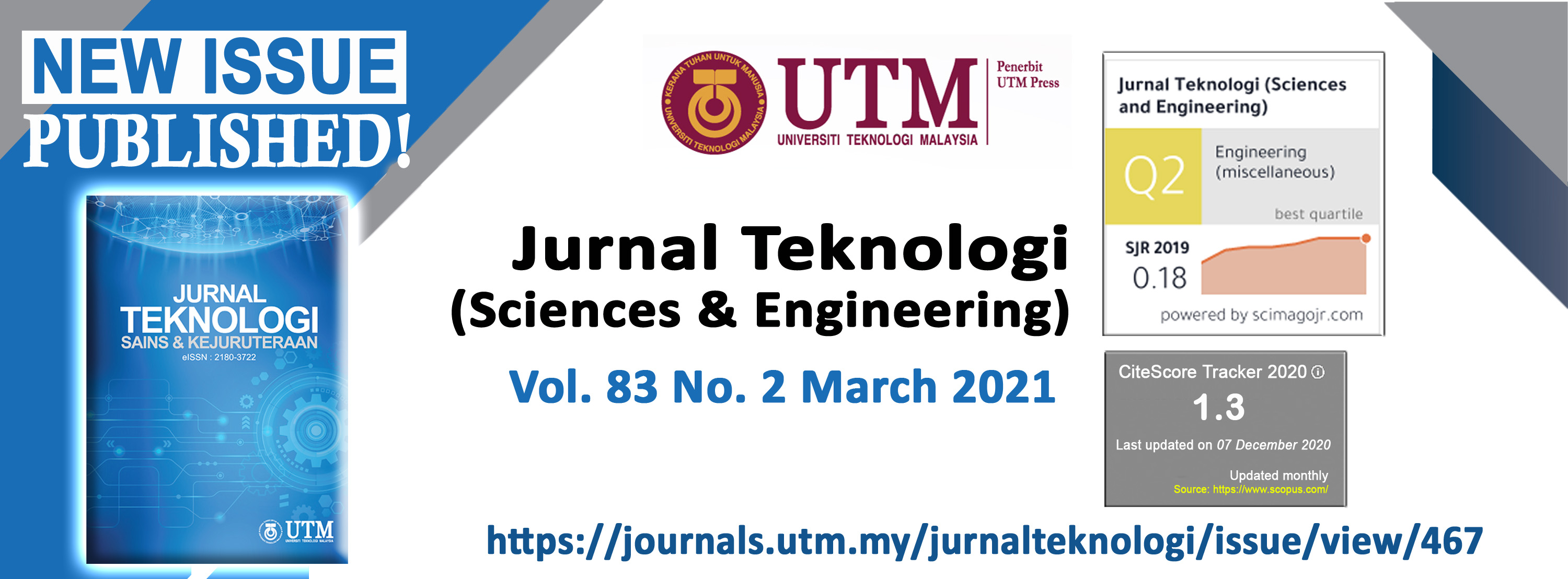EFFECT OF GEOMETRY OF STENOSIS ON THE COMPUTATION OF FLOW CHARACTERISTICS OF UNSTEADY BLOOD FLOW IN A COLLAPSIBLE VESSEL
DOI:
https://doi.org/10.11113/jurnalteknologi.v83.13865Keywords:
Blood flow, streamline-upwind Petrov-Galerkin, stenosis, vessel collapse, fluid-structure interactionAbstract
This paper discusses the effect of different geometric representations of stenosis on the numerical solution of one-dimensional unsteady blood flow in stenotic blood vessel (or stenosis) taking into account fluid-structure interaction. In the formulation, a collapsible pressure-area constitutive relation is added to the coupled mass and momentum equations to allow for the interaction between the cross sectional area, volumetric flow rate and pressure of the flow and hence the prevalence of the one-dimensional fluid-structure interaction. The formulation is stabilized by employing Streamline-Upwind Petrov-Galerkin scheme. Non-reflecting boundary conditions are imposed based on the method of characteristics. Flow characteristics and the geometrical effects of the stenosis are then discussed. Numerical results show that stenosis with irregular shape is more prone to collapse as compared to the smooth one for a given baseline conditions. This study, thus, highlights the importance of representing the shape of the stenosis as close as possible as it might give information otherwise missing in the simplistic smooth representation of the stenosis.
References
Raghu, R. and Taylor, C.A. 2011. Verification of a one-dimensional finite element method for modeling blood flow in the cardiovascular system incorporating a viscoelastic wall model. Finite Elements in Analysis and Design. 47(6): p. 586-592. http://dx.doi.org/10.1016/j.finel.2010.12.012
Downing, J.M., Flow through a compliant stenotic artery: a parametric evaluation, Armstrong Laboratory, 1995.
Downing, J.M. and Ku, D.N. 1997. Effects of Frictional Losses and Pulsatile Flow on the Collapse of Stenotic Arteries. Journal of Biomechanical Engineering. 119(3): p. 317-324. http://dx.doi.org/10.1115/1.2796096
Ku, D. N., Zeigler, M. N. and Downing, J. M. 1990. One-dimensional Steady Inviscid Flow Through a Stenotic Collapsible Tube, ASME Journal of Biomechanical Engineering, 112, p. 444-450.
http://dx.doi.org/10.1115/1.2891209
Sochi, T. 2015. Navier-Stokes Flow in Cylindrical Elastic Tubes. Journal of Applied Fluid Mechanics. 8(2): p. 181-188.
Sochi, T. 2013. One-Dimensional Navier-Stokes Finite Element Flow Model. Imaging Sciences and Biomedical Engineering, King's College London, St Thomas' Hospital, London, England. https://arxiv.org/abs/1304.2320
Sherwin, S.J., Formaggia, L., Peiró, J. and Franke, V. 2003. Computational modelling of 1D blood flow with variable mechanical properties and its application to the simulation of wave propagation in the human arterial system. International Journal for Numerical Methods in Fluids. 43(6-7): p. 673-700.
http://dx.doi.org/10.1002/fld.543
Tang, A.Y., Mohd Noor, M.A., Mohd Yassin, A.Y. and Amin, N. 2017. One-Dimensional Fluid Structure Interaction (1D-FSI) Steady Flow Stable Formulation. International Journal of Engineering Research & Technology. 6(04): p. 1045-1055.
https://www.ijert.org/phocadownload/V6I4/IJERTV6IS040777.pdf
Johnston, P. R. and Kilpatrick, D. 1991. Mathematical Modelling of Flow Through An Irregular Arterial Stenosis. Journal of Bioechanics. 24(11):p. 1069-1077. https://doi.org/10.1016/0021-9290(91)90023-G
Andersson, H. I. Halden, R and Glamsaker, T. 2000. Effects of surface irregularitieres on flow resistance in differently shaped arterial stenoses. Journal of Biomechanics. 33(2000):p. 1257-1262. http://dx.doi.org/10.1016/S0021-9290(00)00088-9
Chakrabarty, S., Mandal, P. K. and Sarifuddin. 2005. Effect of surface irregularities on unsteady pulsatile flow in a compliant artery. International Journal of Non-Linear Mechanics. 40(2005): p. 1268-1281.
http://dx.doi.org/10.1016/j.ijnonlinmec.2005.06.003
Norzieha, M., Mandal, P. K., Jonston, P.R. and Amin, N. 2009. A numerical simulation of unsteady blood flow through multi-irregular arterial stenoses. Applied Mathematical Modelling. 34(2010): p. 1559-1573.
https://doi.org/10.1016/j.apm.2009.09.008
Norzieha, M., Amin, N. Chakravarty, S. and Mandal, P.K. 2009. Unsteady magnetohydrodynamic blood flow through irregular multi-stenosed arteries. Computers in Biology and Medicine. 39(2009): p. 896-906.
https://doi.org/10.1016/j.compbiomed.2009.07.004
Sherwin, S. J., Franke, V., Peiró, J. and Parker, K. 2003. One-dimensional modelling of a vascular network in space-time variables. Journal of Engineering Mathematics, 47 (3-4), 217-250. http://dx.doi.org/10.1023/B%3AENGI.0000007979.32871.e2
Formaggia, L., Lamponi, D. and Quarteroni, A. 2003. One dimensional models for blood flow in arteries. Journal of Engineering Mathematics, 47(3-4), 251-276.
https://doi.org/10.1023/B:ENGI.0000007980.01347.29
Du T, Hu D, Cai D. 2015. Outflow Boundary Conditions for Blood Flow in Arterial Trees. PLOS ONE 10(5): e012859. https://doi.org/10.1371/journal.pone.0128597
Kolachalama, V. B., Bressloff, N. W., Nair, P. B. and Shearman, C. P. 2007. Predictive haemodynamics in a one-dimensional human carotid artery bifurcation. Part I: Application to stent design. IEEE Trans Biomed Eng, 54 (5), 802-812. https://ieeexplore.ieee.org/document/4155000
Nisam, P.R., Binu, L.S. and Sukesh, A.K. 2009. One Dimensional Modelling and Computation of Blood Flow and Pressure of a Stented Artery. 3rd International Conference on Bioinformatics and Biomedical Engineering. 11-13 June 2009. Beijing, China, 1-5.
https://ieeexplore.ieee.org/document/5163145
Boileau, E., Nithiarasu, P., Blanco, P. J., Müller, L. O., Fossan, F. E., Hellevik, L. R., Donders, W. P., Huberts, W., Willemet, M. and Alastruey, J. 2015. A benchmark study of numerical schemes for oneâ€dimensional arterial blood flow modelling. International Journal for Numerical Methods in Biomedical Engineering, 31 (10), 1-33. https://doi.org/10.1002/cnm.2732
Soulaimani, A. and Fortin, M. 1994. Finite element solution of compressible viscous flows using conservative variables. Computer Methods in Applied Mechanics and Engineering. 118(3–4): p. 319-350.
http://dx.doi.org/10.1016/0045-7825(94)90006-X
Donea, J.,Huerta, A., Finite Element Methods for Flow Problems. 2003, England: John Wiley & Sons Ltd. 350.
Downloads
Published
Issue
Section
License
Copyright of articles that appear in Jurnal Teknologi belongs exclusively to Penerbit Universiti Teknologi Malaysia (Penerbit UTM Press). This copyright covers the rights to reproduce the article, including reprints, electronic reproductions, or any other reproductions of similar nature.
















